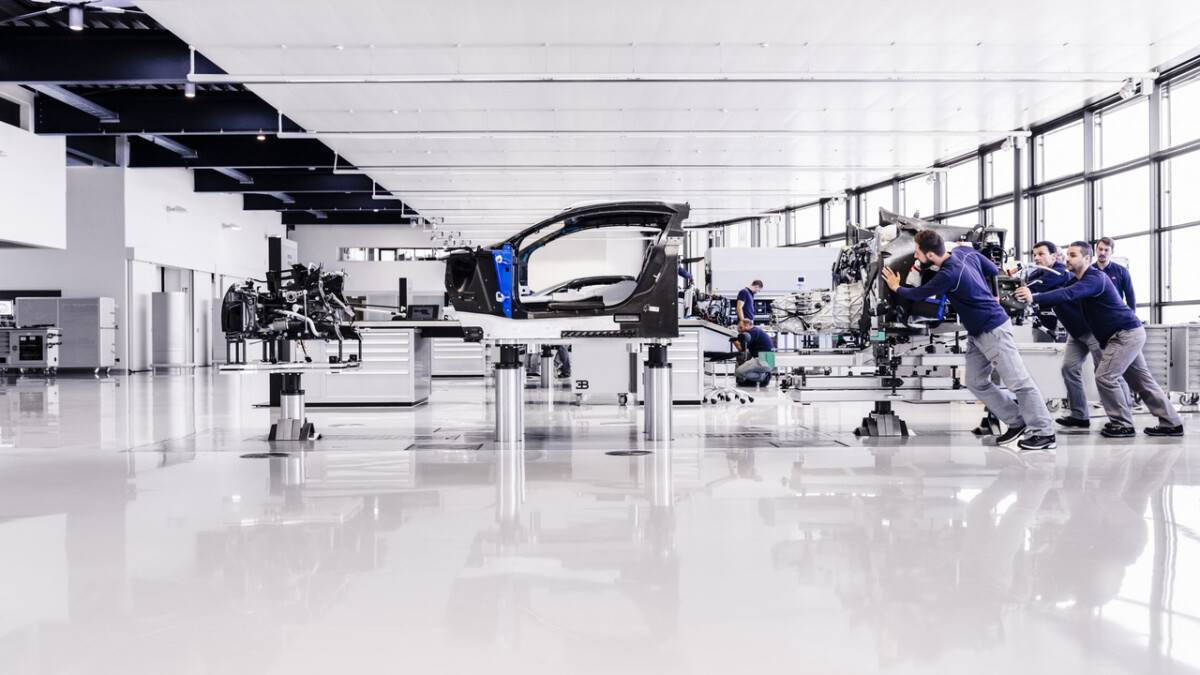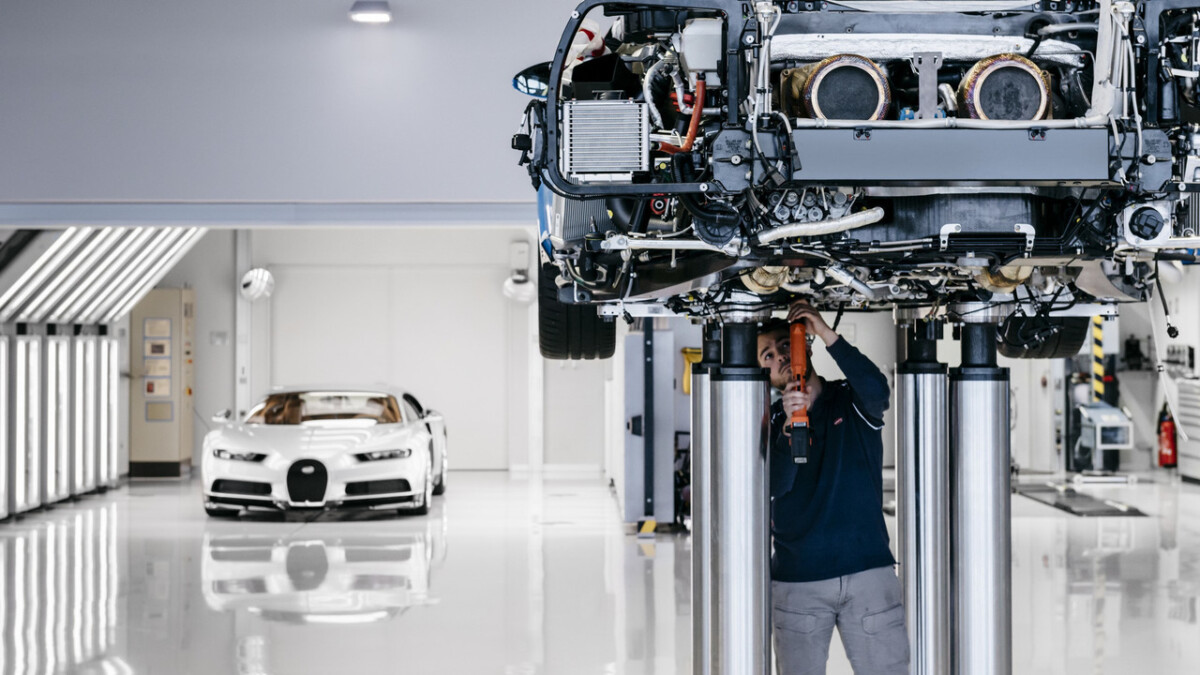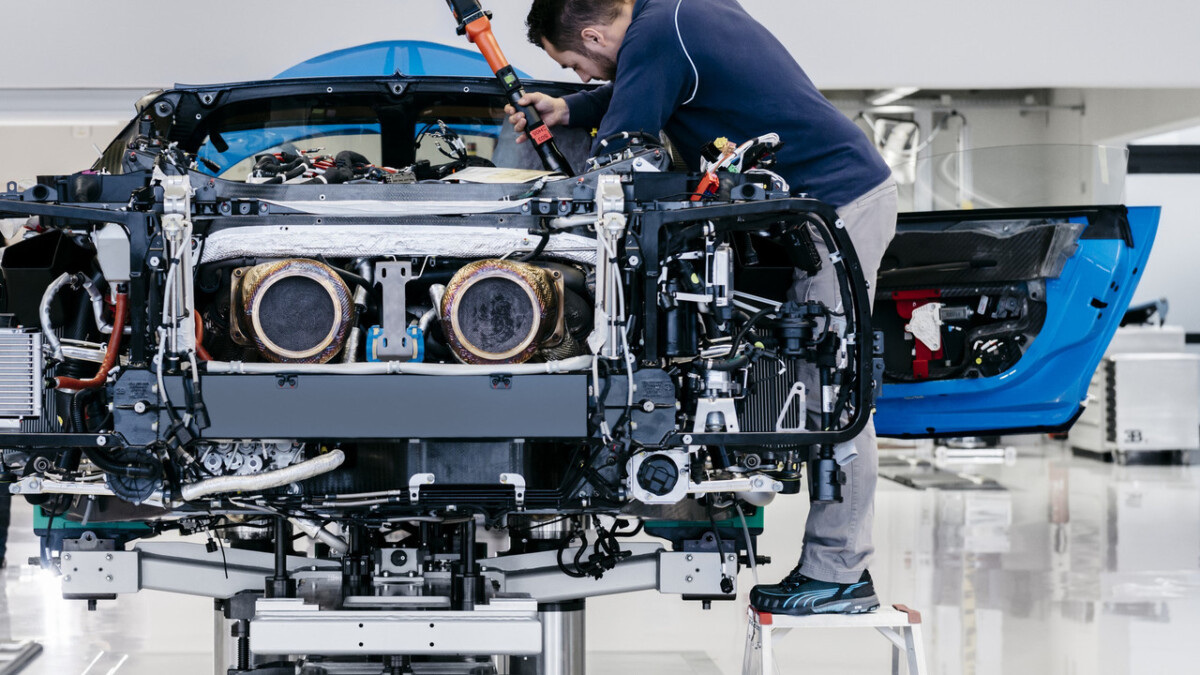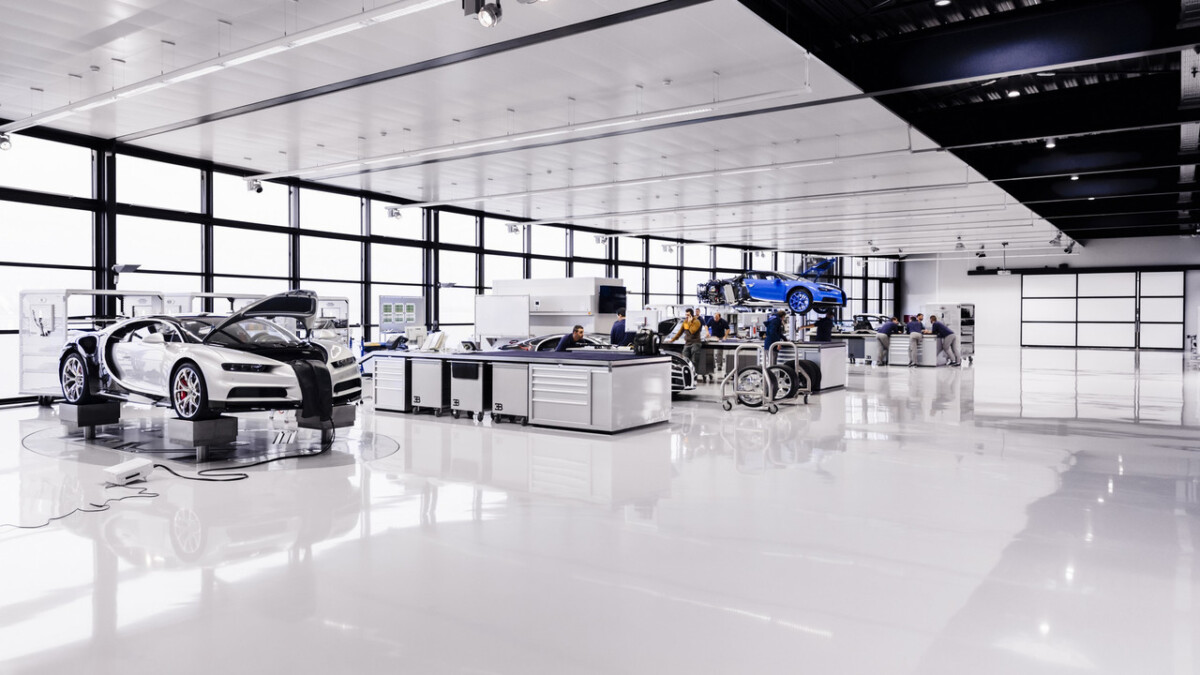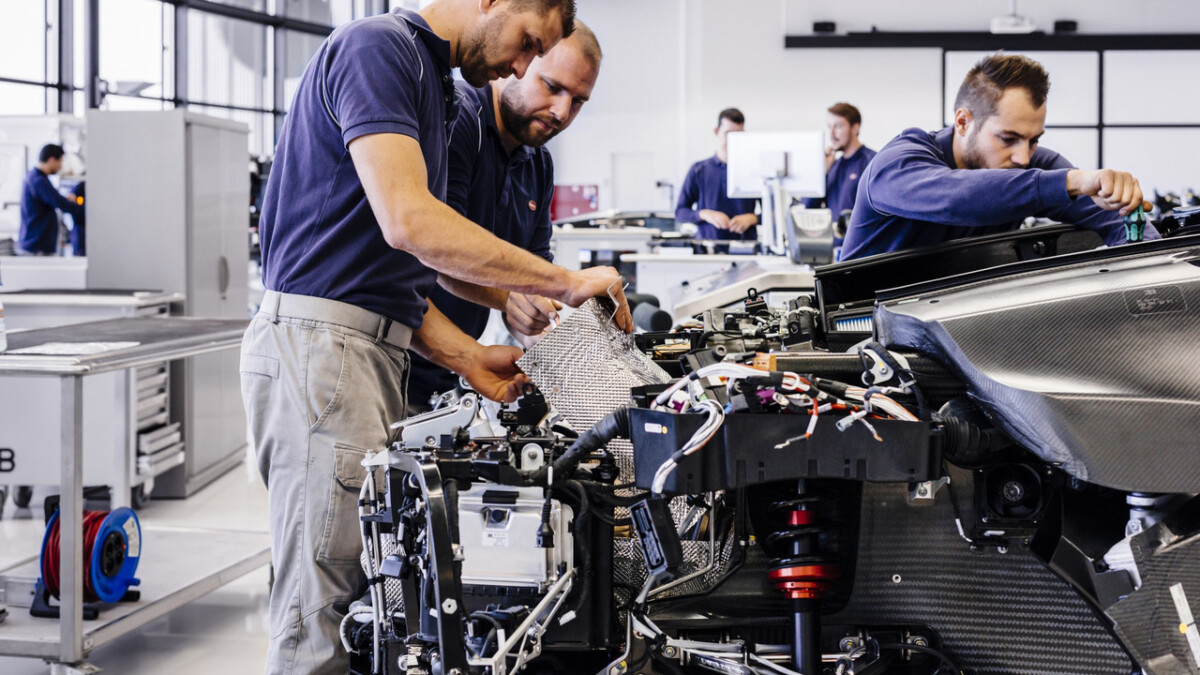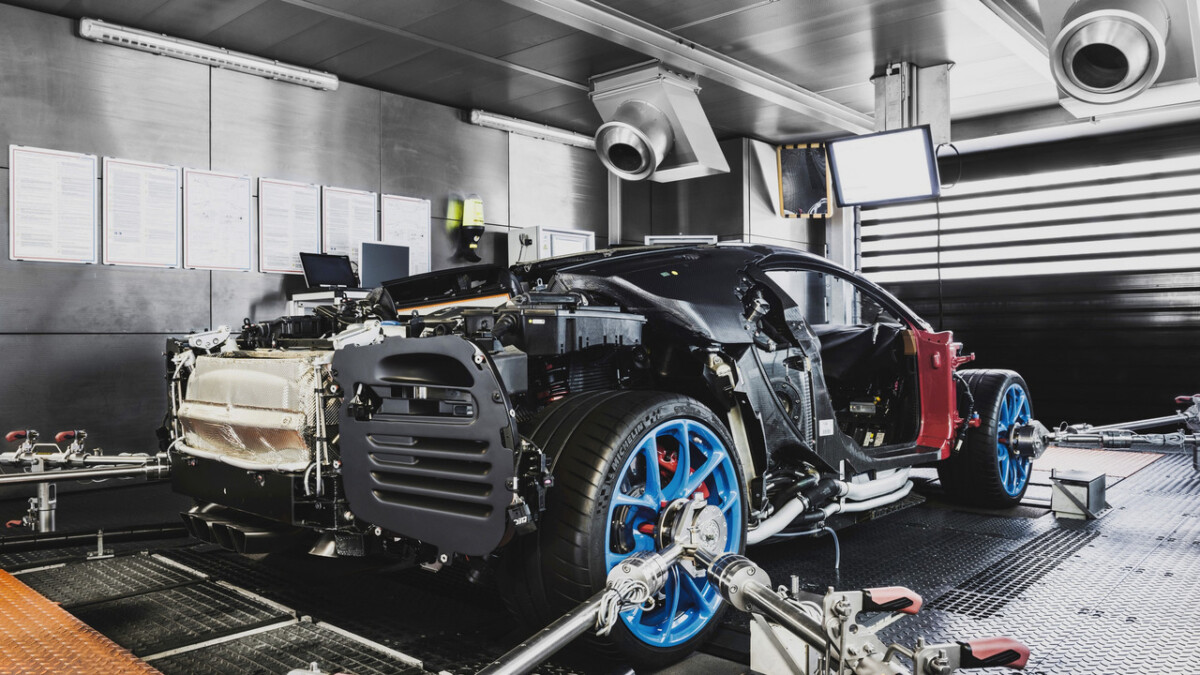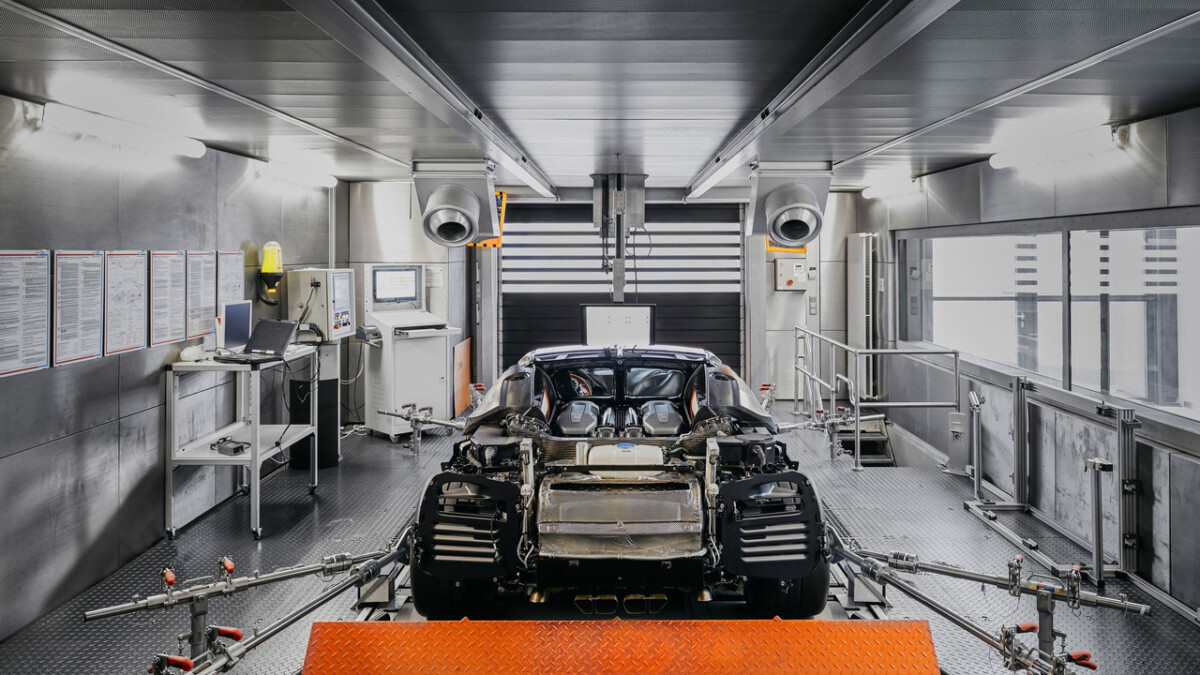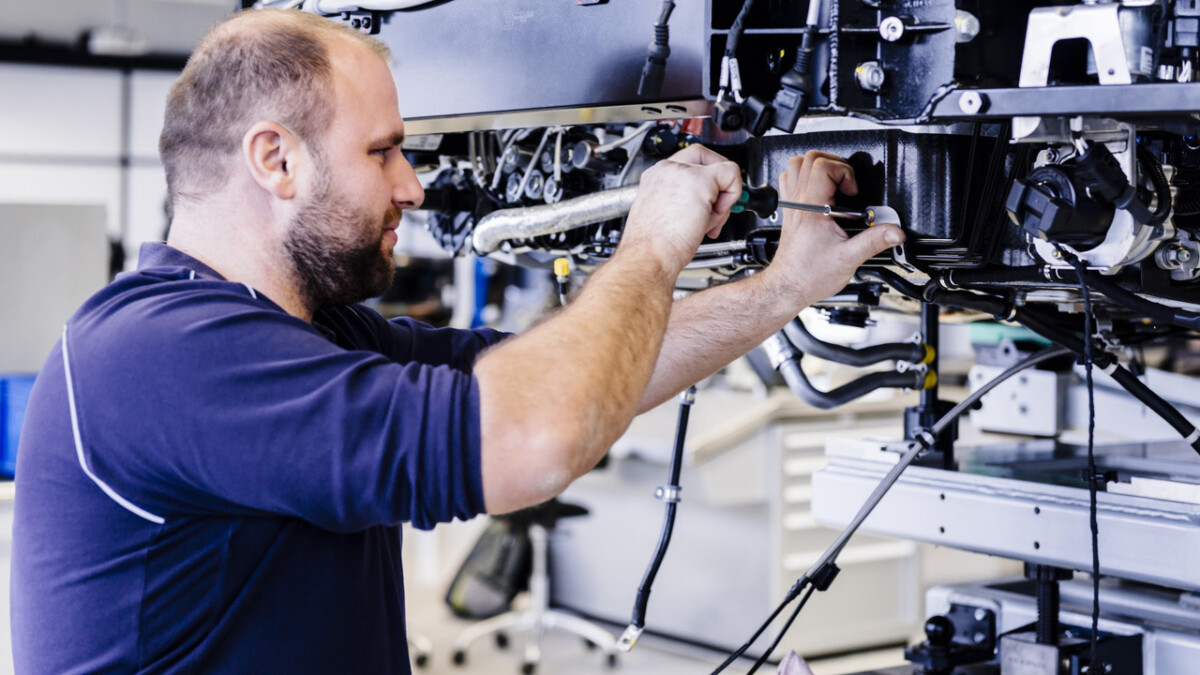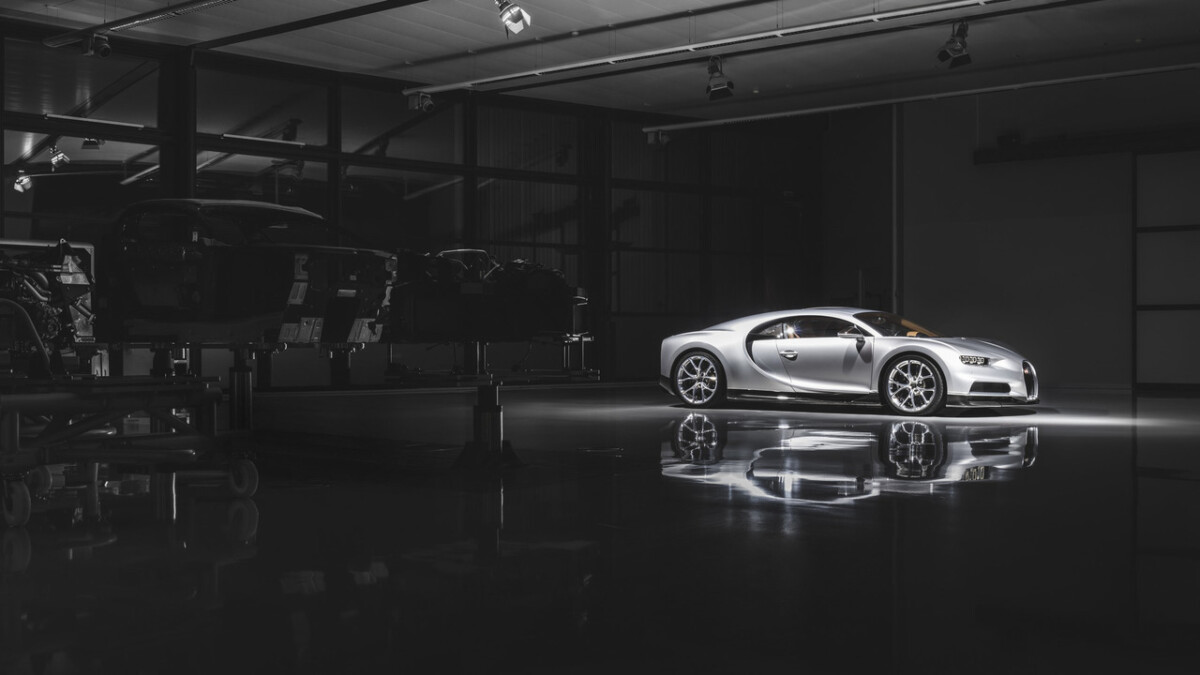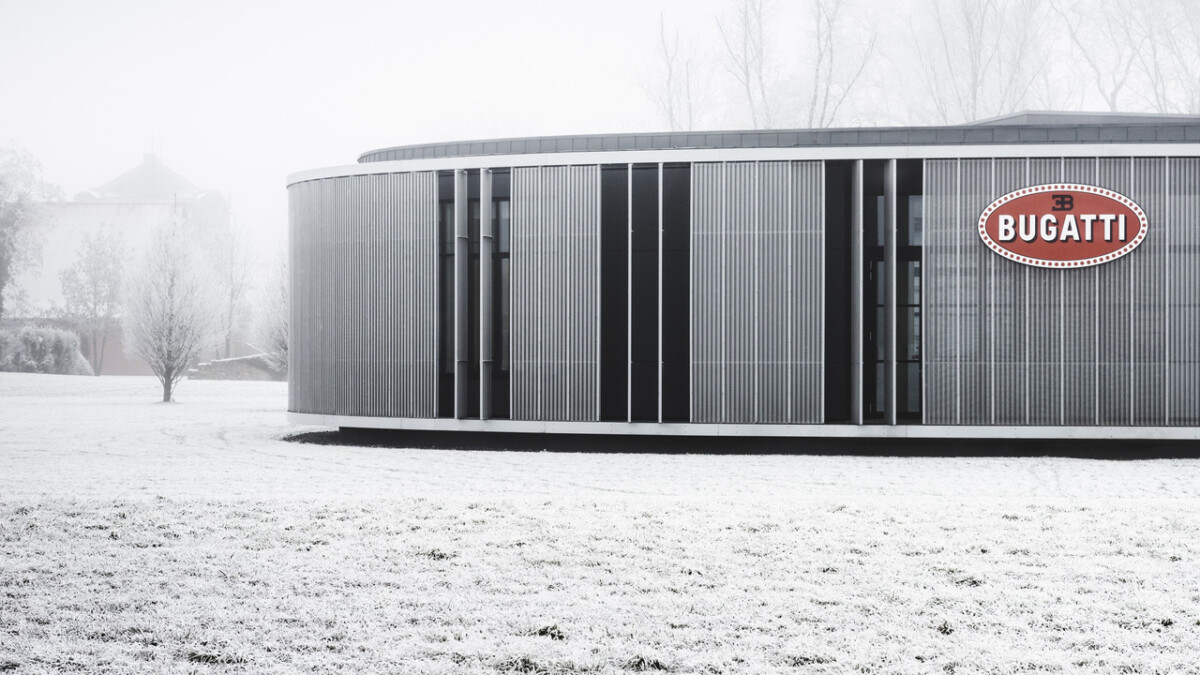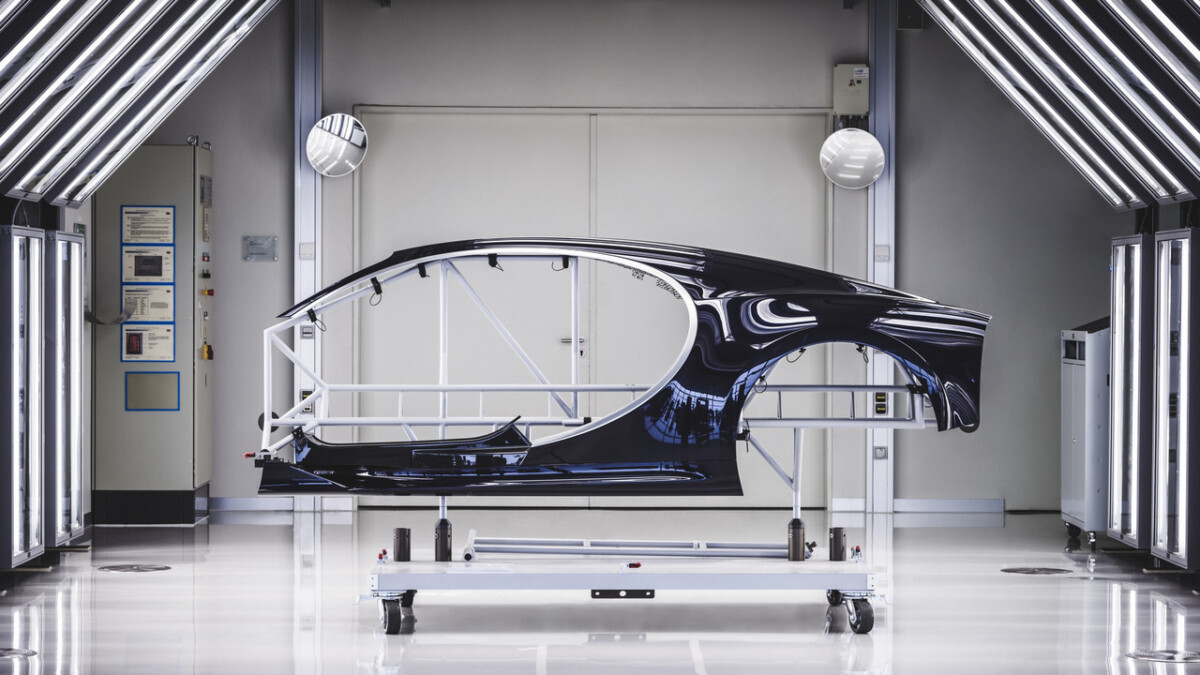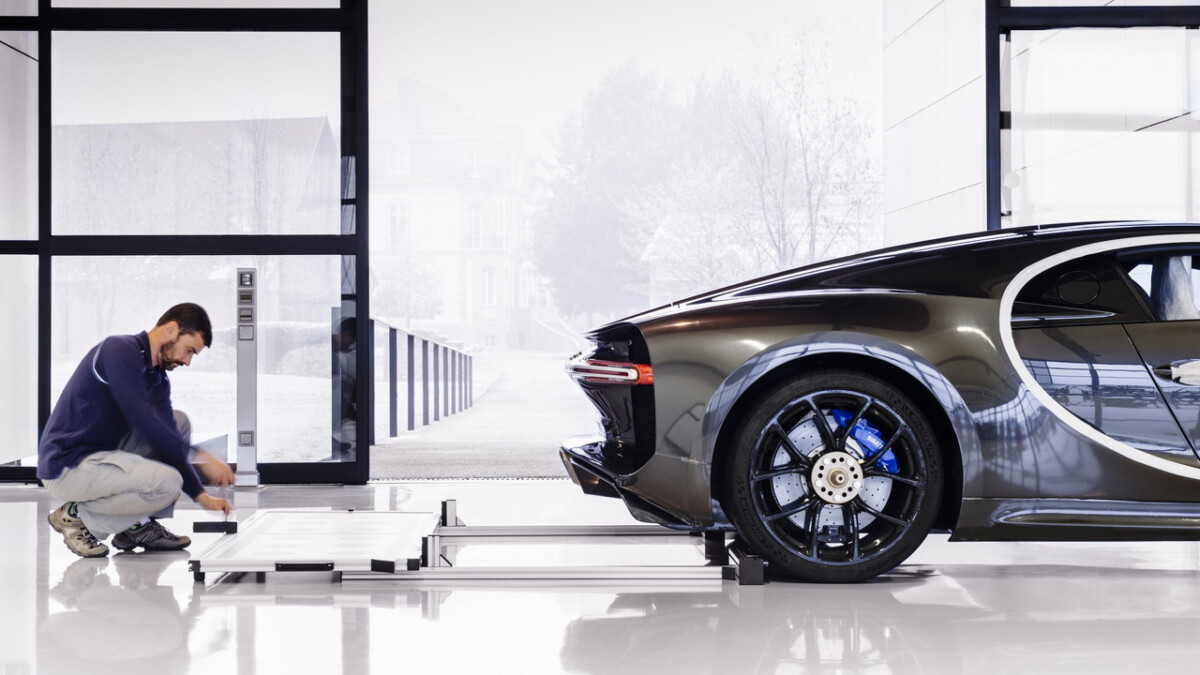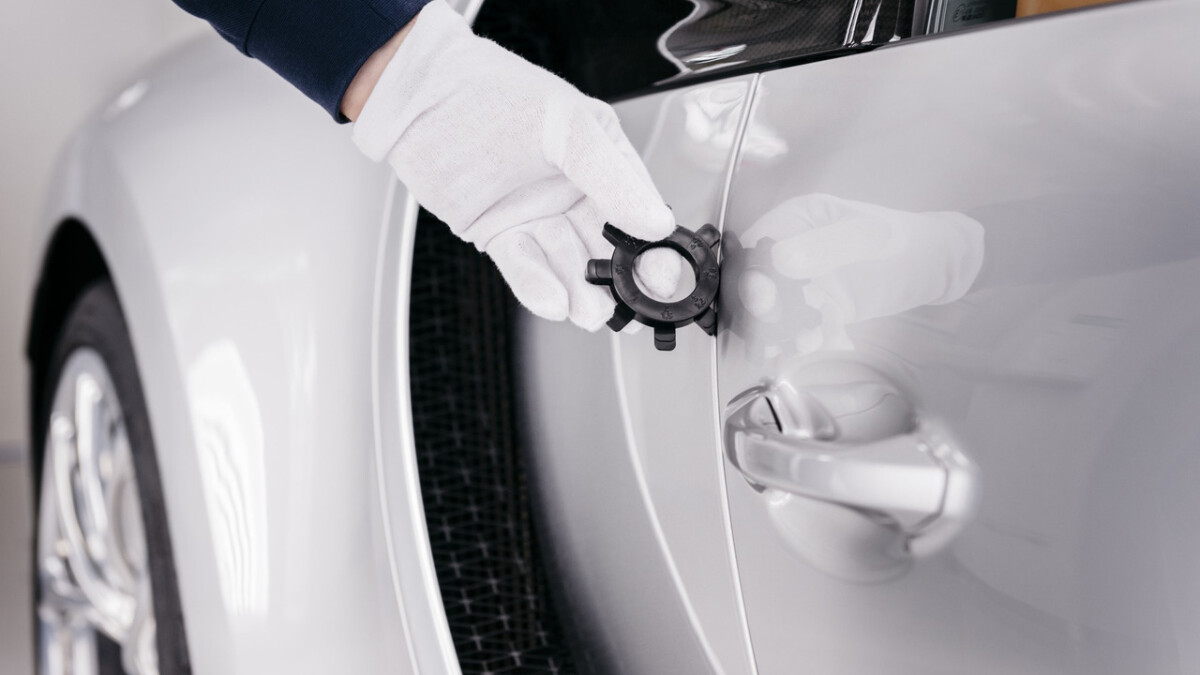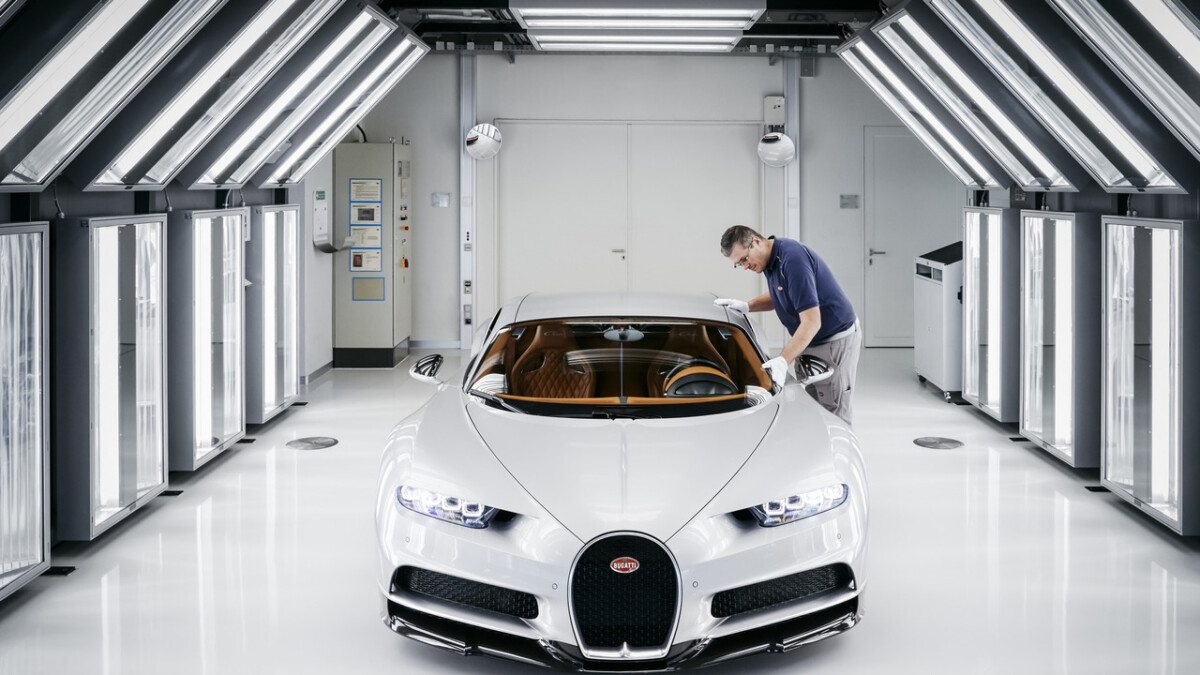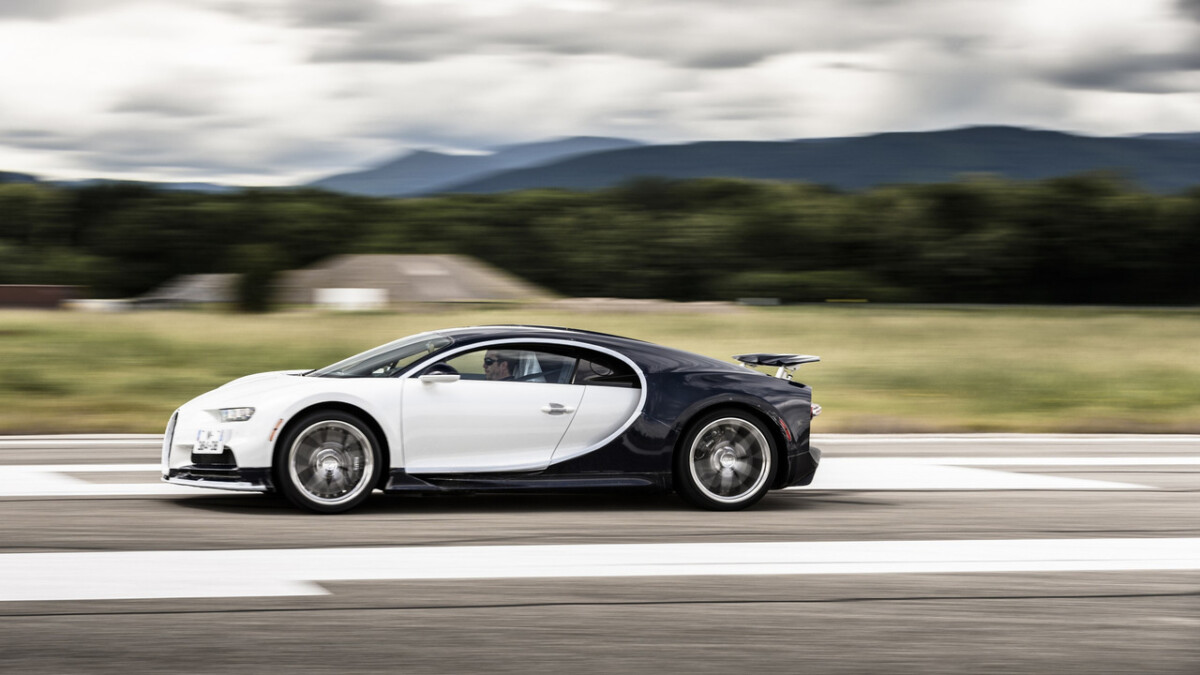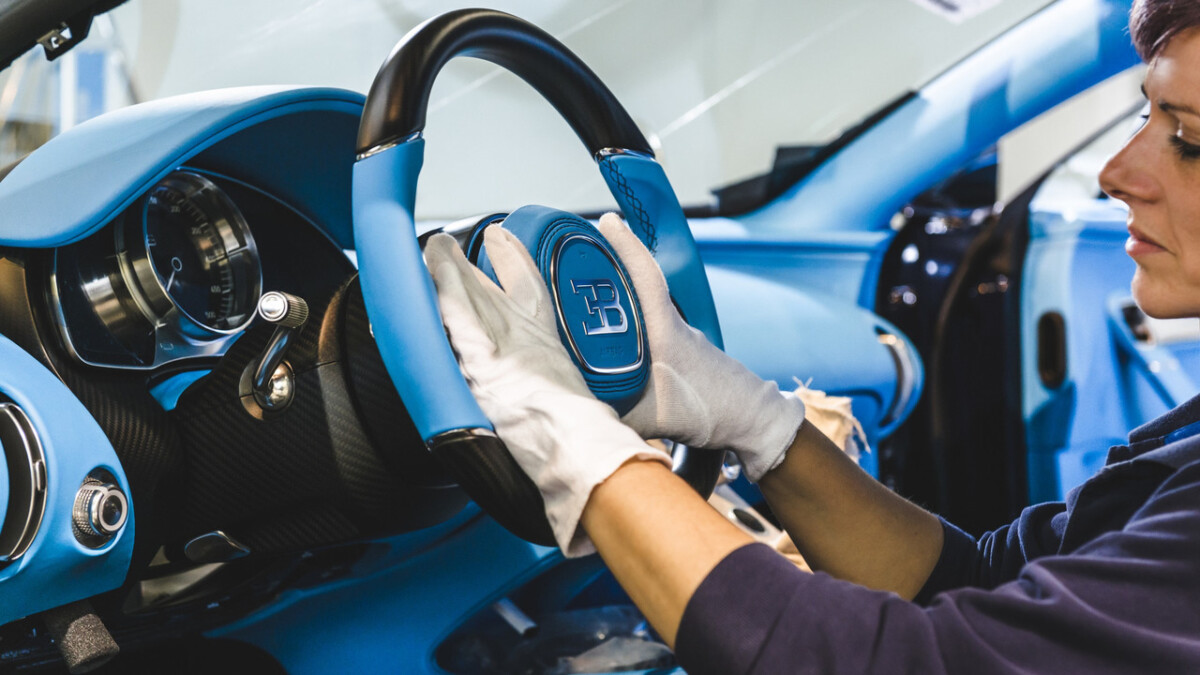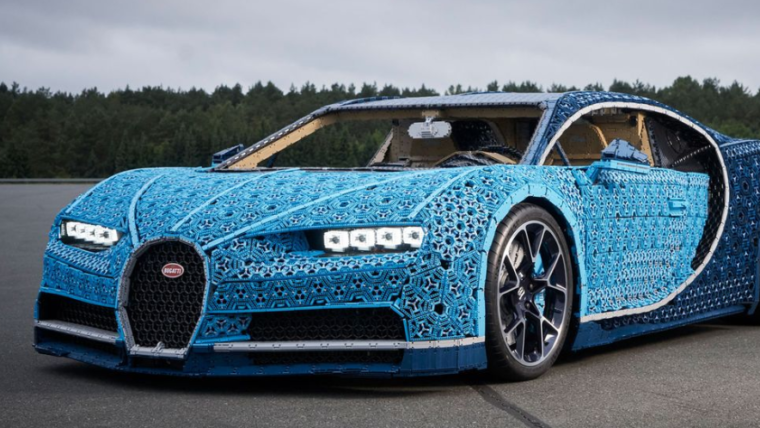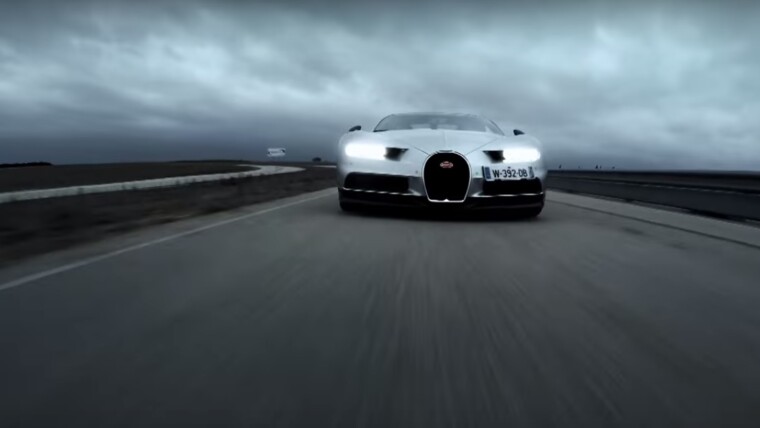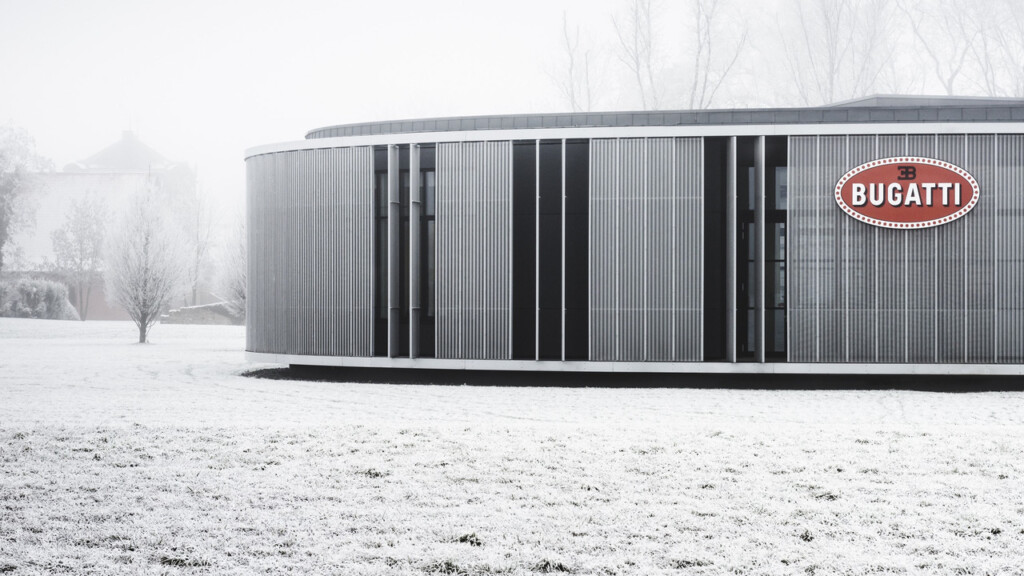
Bugatti has already started production on the Veyron’s successor, the Chiron at the company’s production facility, the so called “Atelier”.
At the time of writing, 12 cars are in production and Bugatti plans to deliver the first vehicles to customers in the first quarter of 2017. The French luxury brand also plans to build up to 70 of these cars this year assembled by 20 employees, including two women, from more than 1,800 individual parts, working solely by hand.
Before customers can take delivery of their new Chiron, there is a lot to do. The first step is the configuration of the vehicle, which is completed by the customer together with a designer from Bugatti. Each Bugatti is unique and is manufactured in accordance with the customer’s personal wishes.
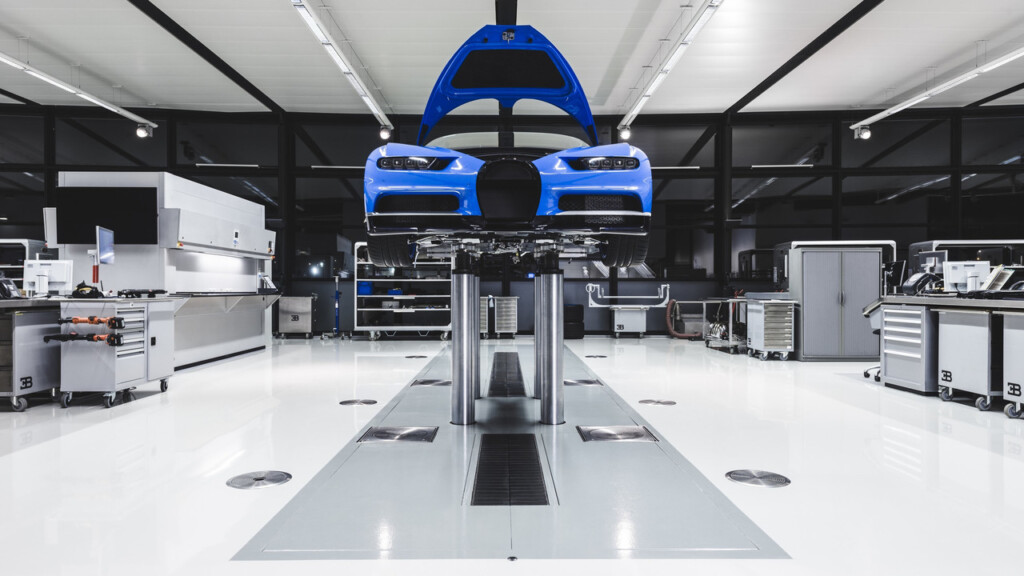
23 topcoat colours and 8 carbon variants form the basic range for the exterior. In the interior, customers can choose from leather in 31 different colours or Alcantara in 8 colours, as well as 30 stitching, 18 carpet and 11 belt colours. In addition to this basic range, thousands of other colours are possible. And in addition to that, individual colours may even be created to match a favourite handbag or even the label on a customer’s preferred brand of mineral water. There are also many other design options such as logos or initials on the bottom of the rear spoiler or embroidery on the headrest and leather inlays on the central console, the customization options here are limitless.
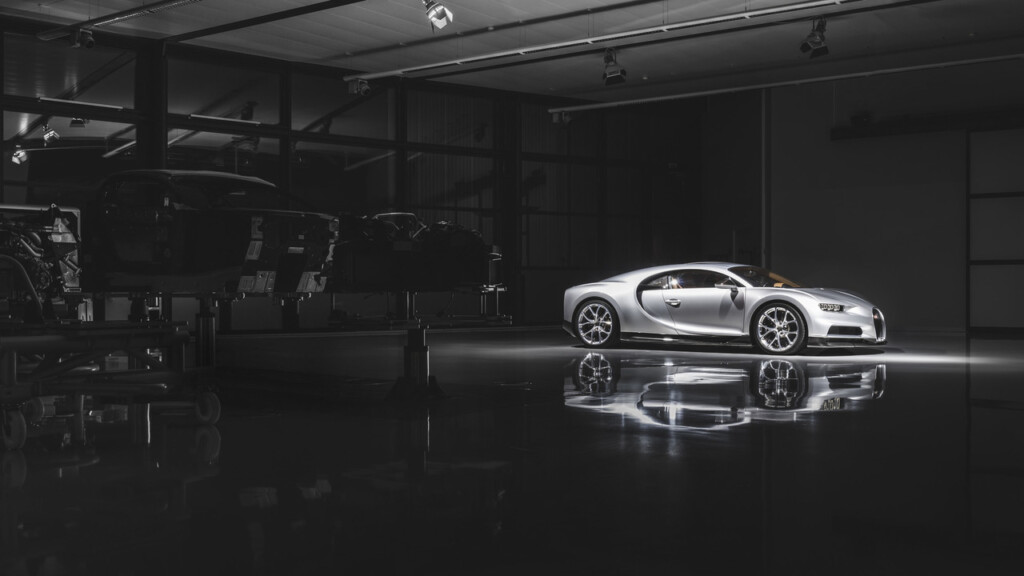
After the customer has signed off the configuration, then only production planning starts. Normally, a Chiron takes about 9 months to produce before it is delivered to its customer. The more unusual a customer’s wishes in terms of materials, colours or other details are, the more time will be required to deliver the car.
When a production slot has been assigned to a customer’s vehicle, the parts that are needed are ordered. From now on, the countdown has started and it will take about 6 months up to the delivery of the car.
One month before the start of production in Molsheim, the bodyshell is assembled with the monocoque and chassis substructure for the first time to ensure that everything fits together perfectly. Each part is assigned a kit number and is then transferred to the paint shop. It takes about 3 weeks to apply the various coats of paint. In the case of visible carbon fibre, six layers are required. For the top coat, up to 8 layers may be needed depending on whether the finish that has been ordered is uni, metallic or pearlescent. The process is so time-consuming because all layers are applied by hand and each individual coat needs to be sanded down and polished before work can start on the next coat.
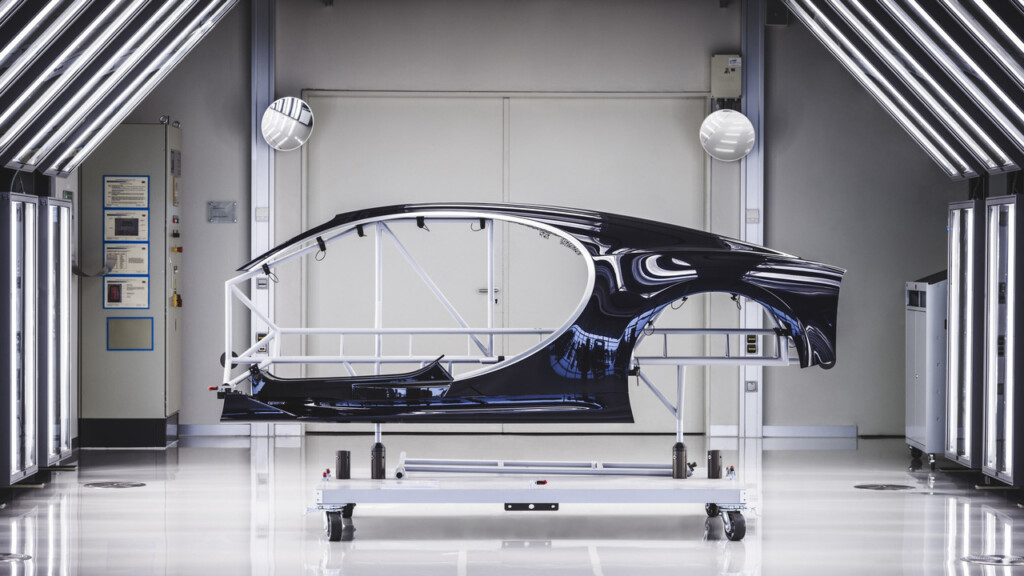
Then the starting signal is given for the assembly of the Chiron in Molsheim. Christophe Piochon, Member of the Bugatti Board of Management responsible for Production and Logistics, watches over production, making sure that all processes run smoothly and there are no hitches.
The production building for the Chiron, which Bugatti calls “Atelier“, has a floor space of more than 1,000 square metres. It was inaugurated in 2005 and has an oval configuration, based on the French brand’s logo, the Bugatti “Macaron”. For more than 10 years, the Veyron 16.4 and its derivatives were built here.
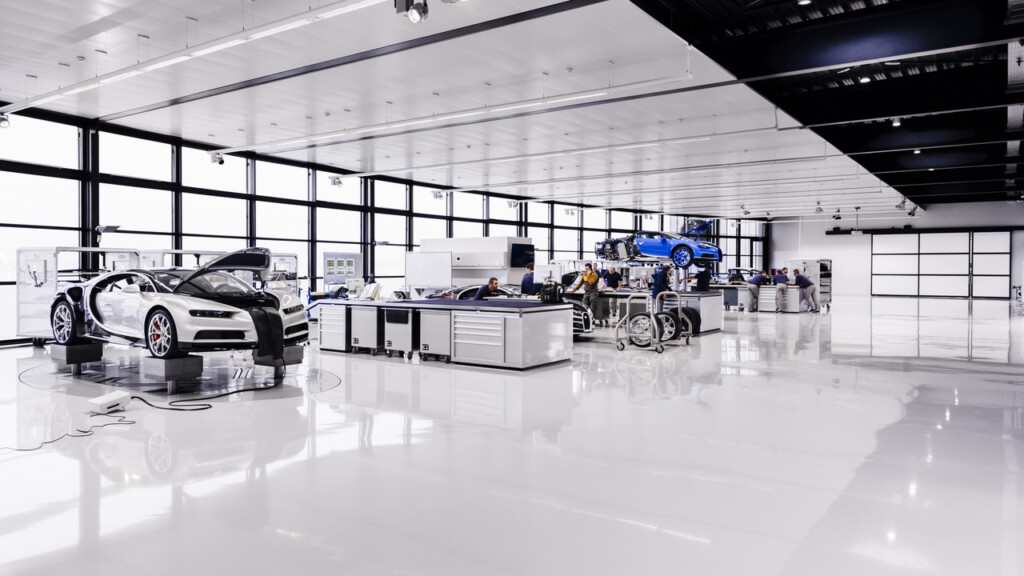
For the Chiron, many modifications were made to the Atelier and associated facilities to take account of the new product properties and increased complexity of the production process. For example, exterior components are now preassembled at the technology centre in the plant area, where they are already subjected to initial inspection. In addition, a new rolling dynamometer was developed to accommodate the 1,500 PS of power developed by the Chiron.
The most striking change is the floor in the Atelier. It is made from epoxy and is conductive, ensuring the dissipation of any electrostatic charges. In addition, the reflecting glossy white creates an atmosphere comparable with the catwalk of a fashion house. “We are building a super sports car. That is quite clear,” says Christophe Piochon. “But it is the way we do it, hand-crafting an individual product for each customer in this very special atmosphere, that makes us unique. This is ‘Haute Couture de l’Automobile'”.
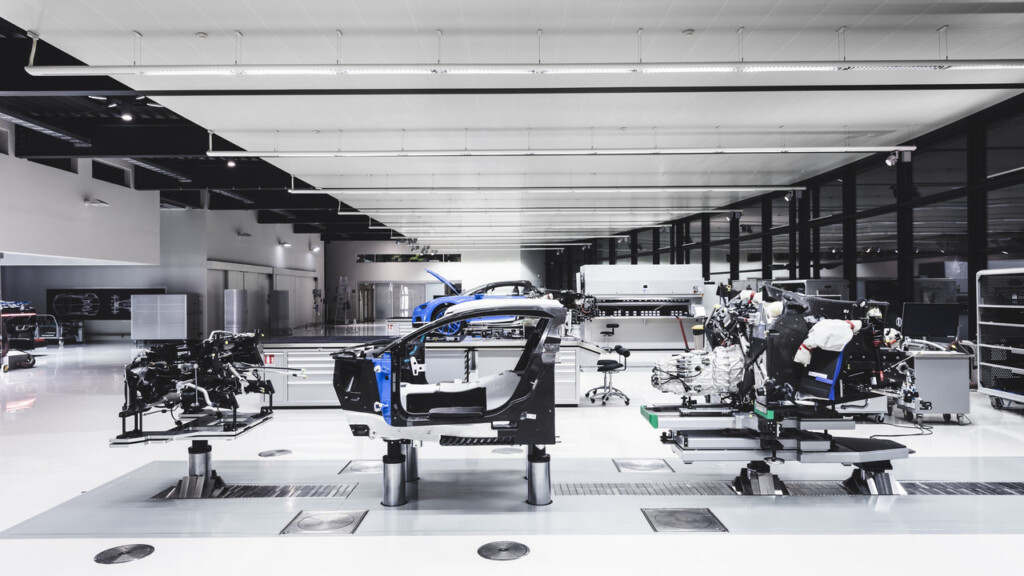
At Bugatti, no conveyor belts nor robots can be found. People work at stations, as in the workshop of a Formula One team. All in all, there are 12 stations. At the first station, the powertrain is prepared for assembly. This is supplied pre-assembled from the Volkswagen Group engine plant in Salzgitter, where specialists build the 1,500 PS engine in a pilot hall equipped exclusively for Bugatti and then put it through its paces on a test bench for 8 hours. At the same time, a similar procedure is applied to the new 7-speed dual-clutch transmission which has been made bigger and stronger to accommodate the high power output of the Chiron and the gigantic torque of 1,600 Nm.
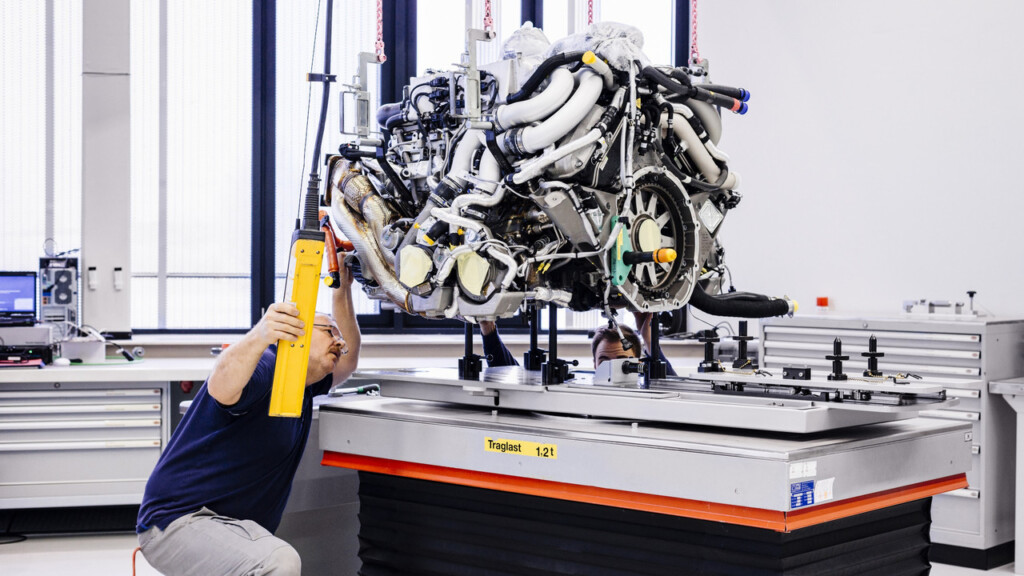
At the second station, the powertrain is installed on the chassis. Thanks to the increased use of carbon and other lightweight materials, this unit weighs 628kg and is no heavier than that of the Veyron, the final version of which had a power output which was 300 PS lower. There are two chassis building platforms in the Atelier. At each station, 3 employees spend about 1 week on the assembly of the chassis. In contrast to a conventional production line worker, each of these employees must be in a position to assemble the entire chassis, including the rear end, monocoque and frame.
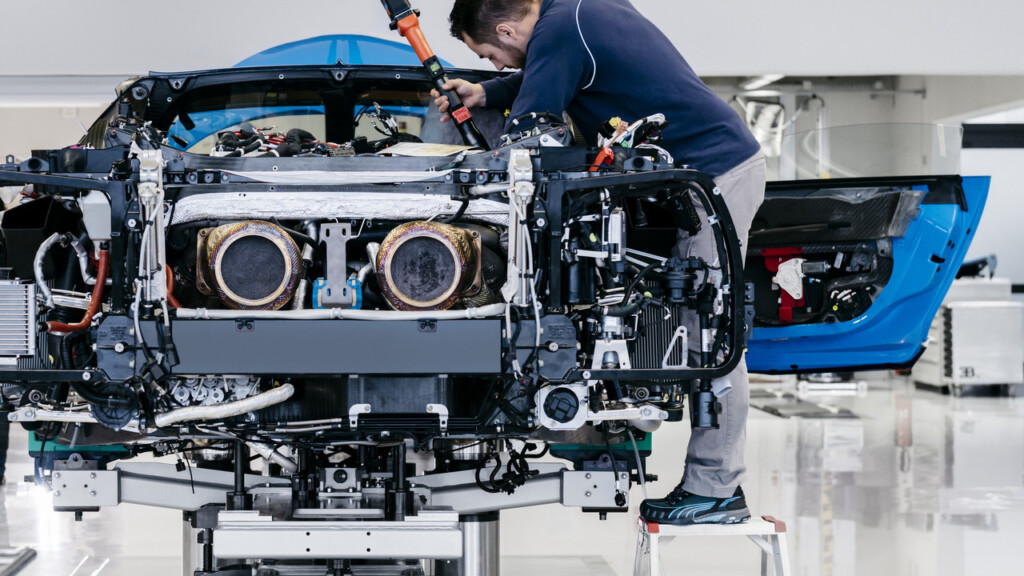
The rear end of the vehicle is built round the powertrain. At the same time, the monocoque and the front end are joined together and equipped with the wiring harnesses required. The pipes connecting the engine at the rear with the radiators at the front are also installed. Cooling is crucially important in the Chiron. The vehicle is equipped with three water pumps, one large pump for the high-temperature cycle and two smaller pumps for the low temperature cycle. The cooling water pipes have the same diameter as a fire brigade’s spray lance and the flow rate is correspondingly high. The coolant flows to the engine along the driver’s side and returns on the passenger’s side after cooling the engine.
The only electronic tool used in chassis assembly is the new EC nutrunner system. This allows a data curve of each bolt tightened on the chassis to be stored on a computer connected to the system, which then gives the assembly worker a signal when the right torque value is reached. There are more than 1,800 bolted joints on a Chiron, with documentation required for 1,068.
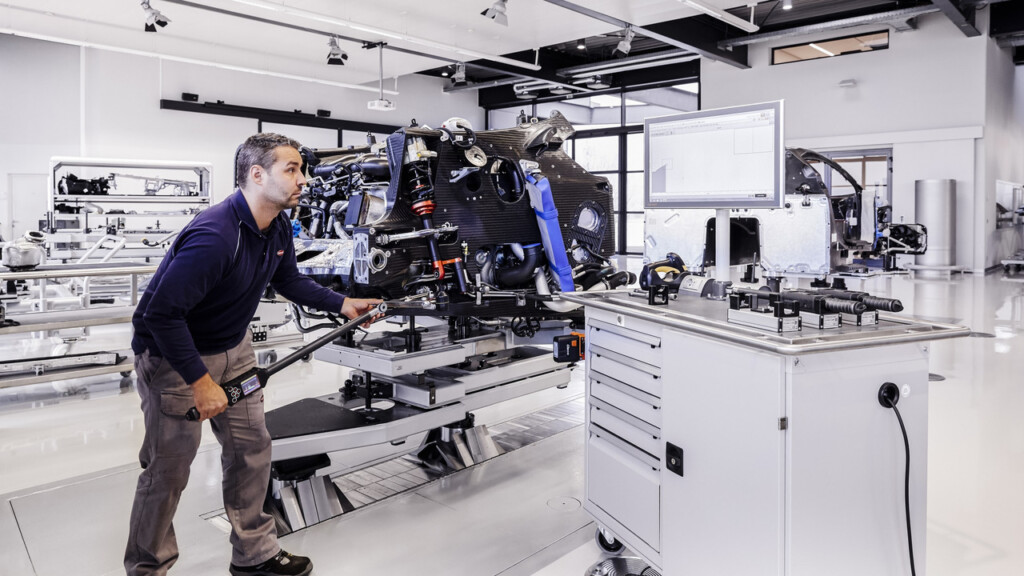
The high point of chassis assembly is definitely the marriage – the operation of joining the monocoque and the rear end. 14 titanium bolts ensure that the bond between the two units is durable and extremely strong. Titanium was selected to save weight; each bolt only weighs 34 grams.
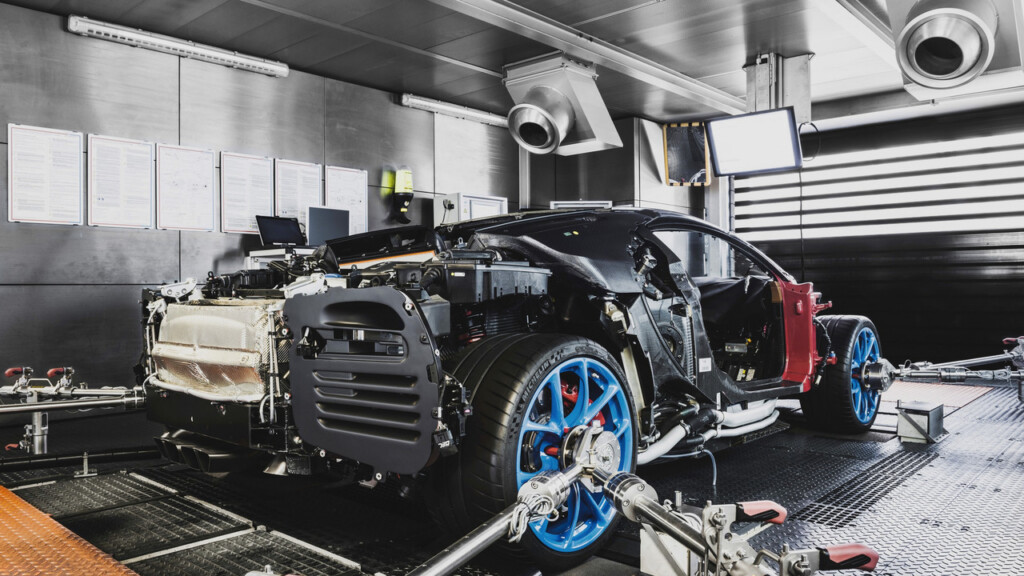
Finally, 4 wheels are bolted to the chassis and it then rolls forward to the next station – the filling unit, where all the operating fluids are filled into the vehicle: engine and transmission oil, brake fluid, hydraulic fluid and coolant. The coolant is filled in under vacuum which is maintained for 10 minutes in order to test the coolant cycle for any leaks again. This is where the 16-cylinder engine is started in the vehicle for the first time.
After this stage, the chassis travels a few metres to the rolling dynamometer. This is the part of the production facility that called for the greatest investment in preparation for the Chiron. The modifications, including larger electric cables, were necessary as the old rolling dynamometer could not absorb the 1,500 PS and 1,600 Nm developed by the Chiron. The new unit is so powerful that it can produce electricity with a current of up to 1,200 amps during operation. Bugatti feeds the excess power generated to the local grid in Molsheim. The Bugatti rolling dynamometer is the most powerful of its type in the world.
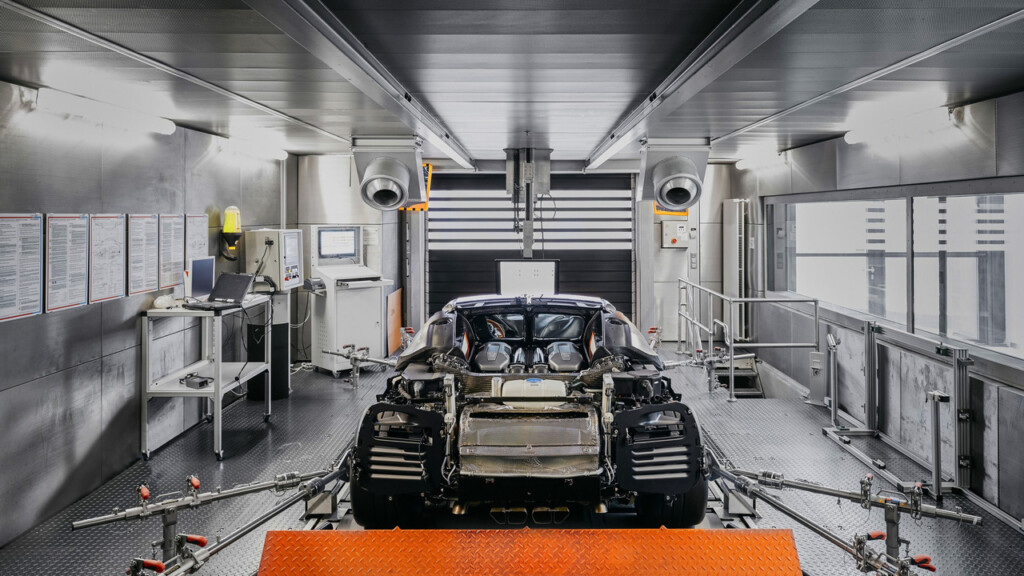
The dynamometer is installed in a separate room with its own ventilation system for vehicle cooling and pollution control. For safety reasons, all the wheels of the car are fastened to the floor using special adapters. Speeds of up to 200 km/h and acceleration under full power (1,500 PS) can be simulated. A team member sits behind the wheel and follows all the tests on the monitor. Among other things, he monitors the engine settings, communication between the engine and transmission, the adjustment of the mass airflow meter and the clutch as well as the functioning of ESC, ABS and other programs. The tests take between 2 and 3 hours, during which time the vehicle covers about 60km.
When the Chiron has passed all its tests on the rolling dynamometer, it is fitted with its exterior skin at the following station. Here, the exterior parts, which are made entirely from carbon, are installed on the vehicle. As some of the individual lightweight parts are very large and fragile, this work is extremely demanding, which is why a pre-assembly stage was introduced for the Chiron. Pre-assembly is completed in Bugatti’s new technology centre, which is located only 200 metres away from the Atelier. The body parts are installed here on special mobile frames, with assembly points identical to those of the Chiron. The lighting conditions in this assembly hall are the same as in the Atelier, which means that any problems with the paintwork or damage to individual parts can be identified and remedied before the parts are installed on the vehicle. It takes between 3 and 4 days before the body parts have been installed on the Chiron and the gaps and joints have been precisely adjusted.
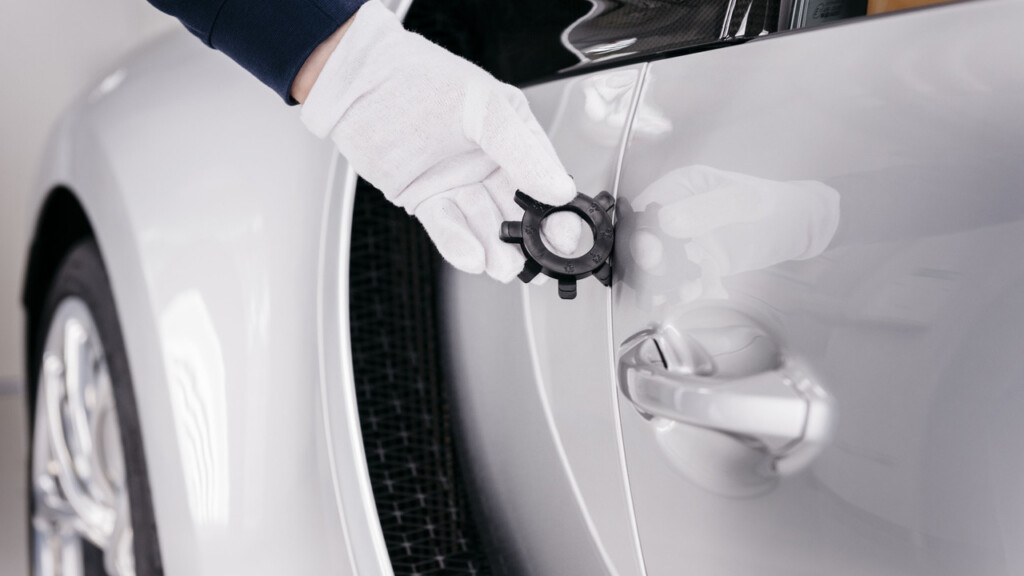
The next stage is a water test. Here, the Chiron is exposed to monsoon rain of varying intensity for 30 minutes to show that there are no leaks.
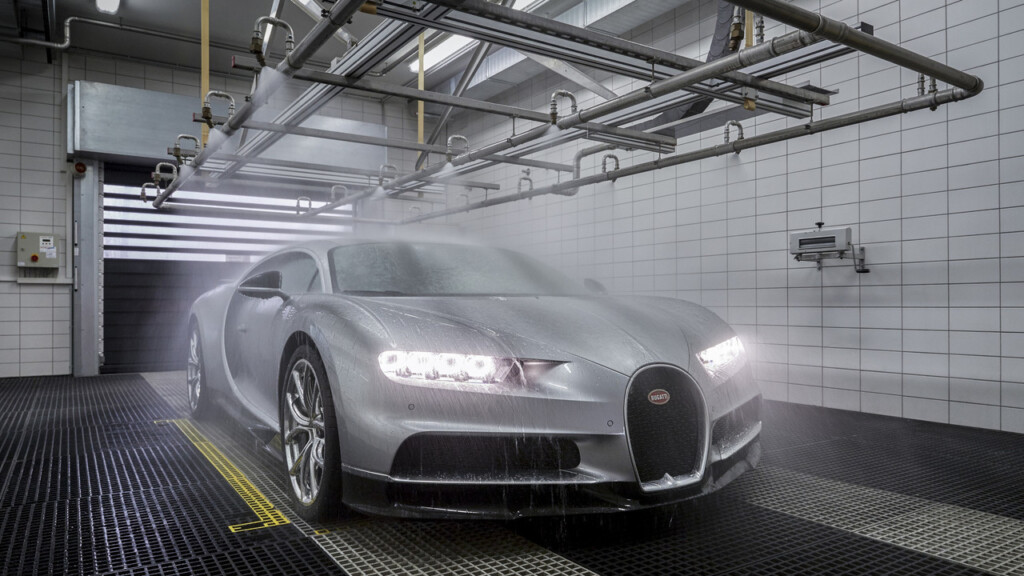
The interior fittings are only installed when this test has been completed. Here, 2 team members make sure that all the parts are installed in the right place in the interior of the Chiron, a process that normally takes about 3 days. Customers can choose between a luxurious variant with full leather trim or a more sporty combination of leather and carbon fibre.
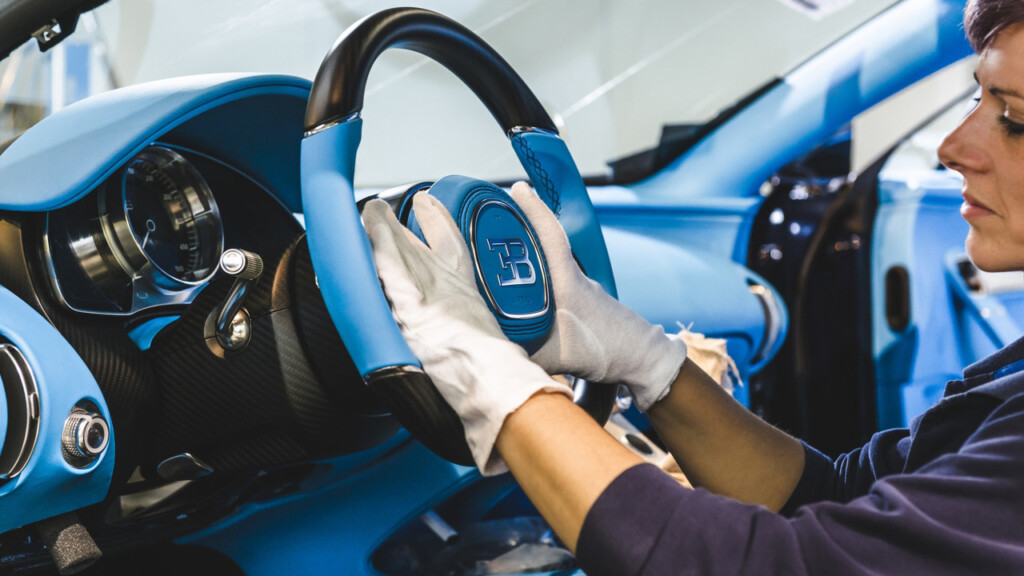
When the interior has been completed, the Chiron is prepared for its test and final inspection drive. For this purpose, the entire super car is covered by a strong transparent plastic foil. This process alone takes a whole day. A further day is required for removing the foil and cleaning the vehicle following the test drive.
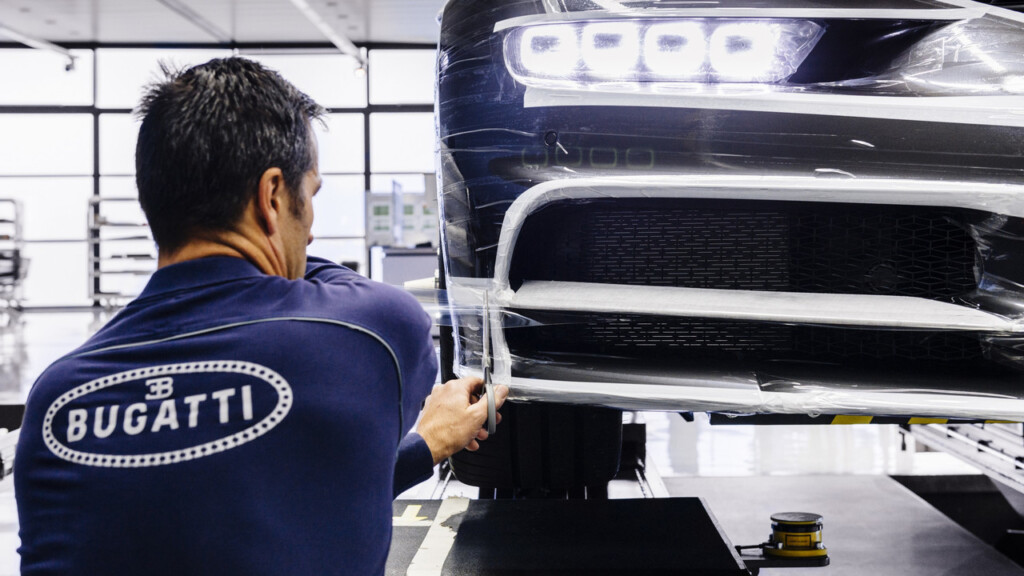
Before the Chiron leaves the Atelier for the first time on its test drive, the electronic functions of the vehicle are tested and the track of the wheels is adjusted. By the way, Bugatti does not use the original wheels and underbody on the test drive to ensure that these parts are protected against wear and damage. During the test drive, the Chiron is driven 300 km through the Vosges to the airport in Colmar, where it completes test of functions requiring speeds in excess of 250 km/h on the runway. The return trip is covered at a more “relaxed” pace on the Autobahn to allow the vehicle to cool down. If the test driver gives the Chiron the thumbs up following the trip, the transmission oil is changed and the original wheels and underbody are installed in the Atelier. The car then completes a last test drive over 50 km before final dynamic approval is given.
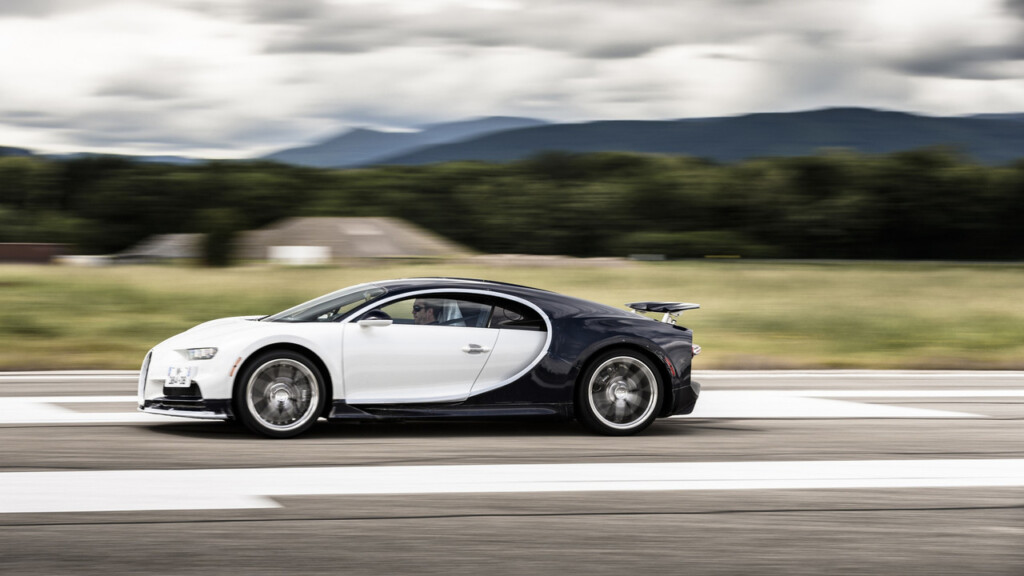
At this stage, the Chiron is transferred to the paint booth, where it is prepared for the finish. All the protective foils are removed and the vehicle is then cleaned and polished. The cosmetic preparation of the Chiron takes two days before it is transferred to the light tunnel. Here, a team member carries out a relentless inspection of the finish for more than 6 hours, after which the Chiron returns to the paint booth. The team member then devotes himself to intensive optimization until all the visible blemishes have been remedied. This can take between 3 hours and 3 weeks if a highly personalised component needs to be produced again. When the auditor in the light tunnel has given his final approval of the finish, Christophe Piochon meets the Heads of the Sales, Quality Assurance and Customer Service Departments for management approval. Only when the managers are satisfied with the condition of the vehicle can an appointment for handing over to the customer be arranged.
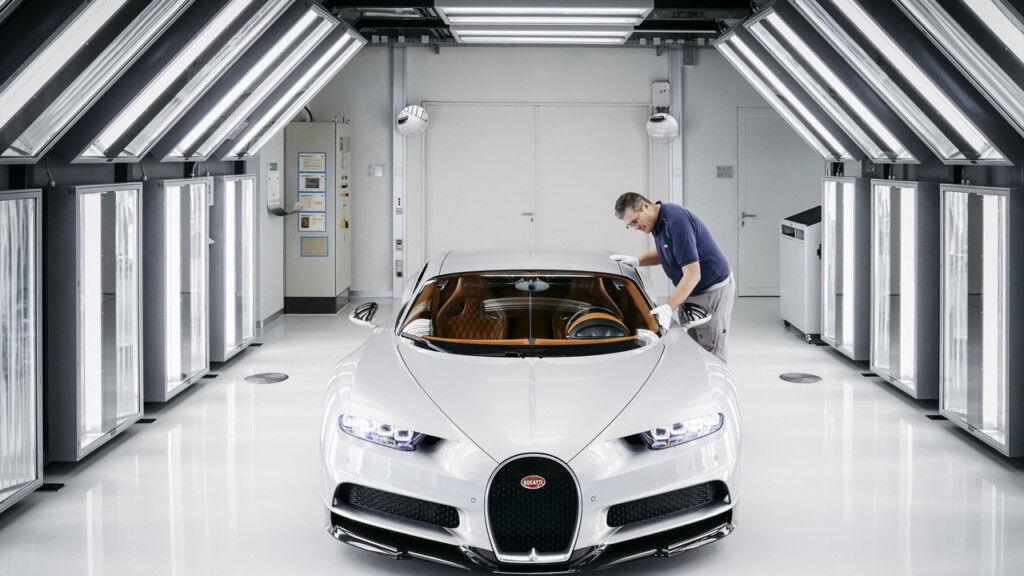
Usually, the customer will already have visited Molsheim several times by then. Following a test drive in a demonstration vehicle, the signature of the contract and the configuration of their own personal Chiron, customers will get the opportunity to witness the creation of their vehicle personally during production in the Atelier. Those, who really want to, can even spend a day working on their own sports car.
Other posts by AF Newsdesk


